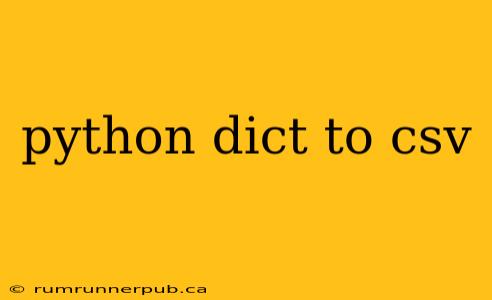Exporting data from a Python dictionary to a CSV (Comma Separated Values) file is a common task in data processing and manipulation. This guide will walk you through several approaches, drawing on insightful solutions from Stack Overflow, and enhancing them with explanations and practical examples.
Method 1: Using the csv module (Recommended)
This is the most straightforward and efficient method for most scenarios. The built-in csv module provides robust functionality for working with CSV files.
Stack Overflow Inspiration: While there isn't one single definitive Stack Overflow answer for this, many threads address aspects of this problem (e.g., handling different dictionary structures). This method draws inspiration from the collective knowledge found in those discussions.
Code Example:
import csv
data = [
{'name': 'Alice', 'age': 30, 'city': 'New York'},
{'name': 'Bob', 'age': 25, 'city': 'Los Angeles'},
{'name': 'Charlie', 'age': 35, 'city': 'Chicago'}
]
# Get fieldnames from the first dictionary (assuming all dictionaries have the same keys)
fieldnames = data[0].keys()
with open('data.csv', 'w', newline='') as csvfile:
writer = csv.DictWriter(csvfile, fieldnames=fieldnames)
writer.writeheader()
writer.writerows(data)
print("CSV file 'data.csv' created successfully.")
Explanation:
- We import the
csvmodule. - We define a list of dictionaries,
data. This is a typical structure for representing tabular data in Python. - We extract the field names (column headers) from the keys of the first dictionary. This assumes all dictionaries have the same keys; otherwise, you'll need a more sophisticated approach to handle inconsistencies.
- We open a CSV file in write mode (
'w') withnewline=''to prevent extra blank rows on some systems. - We create a
csv.DictWriterobject, specifying the field names. - We write the header row using
writeheader(). - Finally, we write all the rows from our
datalist usingwriterows().
Handling Inconsistent Dictionaries: If your dictionaries have varying keys, you'll need to pre-process your data to ensure all dictionaries have the same keys, perhaps filling missing values with None or other placeholders.
Method 2: Using the pandas library (For Larger Datasets)
For larger datasets or more complex data manipulation, the pandas library offers a more powerful and flexible solution.
Stack Overflow Inspiration: Again, numerous Stack Overflow questions and answers relate to using pandas for CSV export, often involving data cleaning and transformation before writing to the file.
Code Example:
import pandas as pd
data = [
{'name': 'Alice', 'age': 30, 'city': 'New York'},
{'name': 'Bob', 'age': 25, 'city': 'Los Angeles'},
{'name': 'Charlie', 'age': 35, 'city': 'Chicago'}
]
df = pd.DataFrame(data)
df.to_csv('data_pandas.csv', index=False)
print("CSV file 'data_pandas.csv' created successfully.")
Explanation:
- We import the
pandaslibrary. - We create a pandas DataFrame from our list of dictionaries.
- We use the
to_csv()method to write the DataFrame to a CSV file.index=Falseprevents writing the DataFrame index to the CSV.
Advantages of pandas: Pandas provides excellent features for data cleaning, transformation, and analysis before exporting to CSV, making it ideal for larger and more complex datasets.
Choosing the Right Method
- For small to medium-sized datasets with consistent dictionary structures, the
csvmodule is sufficient and efficient. - For large datasets, complex data manipulations, or advanced data analysis before export,
pandasis a more powerful choice.
Remember to install pandas if you choose to use the second method: pip install pandas
This article provides a practical guide to exporting Python dictionaries to CSV files, building upon the collective wisdom of Stack Overflow contributors and adding valuable context and explanations to make it even more useful. Remember to always handle potential errors (like IOError when opening the file) in a production environment.
